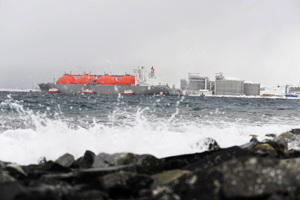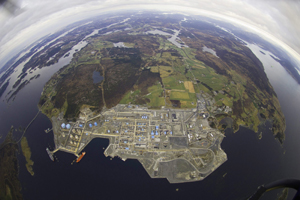The uncertain prospects of Norwegian gas
on
The uncertain prospects of Norwegian gas
It is generally accepted that Norwegian oil production peaked in 2001, but both in Norway and in the EU it is assumed that gas production in Norway will continue to grow in the next twenty years. A recent study from researchers from the University of Uppsala in Sweden, however, predicts that Norway’s gas production will peak between 2014 and 2020. The Norwegian Petroleum Directorate rejects this pessimistic outlook – but does not provide an alternative of its own. Norwegian Energy Minister Terje Riis-Johansen concedes that ‘if we don’t make any significant discoveries in the future, it will be difficult to supply as much gas to Europe as we would wish.’ Market players meanwhile demand a more active policy from the Norwegian government to ensure that production will be kept up.
 |
| LNG plant at Melkøya, Norway (Photo: Helge Hansen / Statoil) |
As domestic production in the EU is expected to decline, gas demand is likely to grow, and the EU wants to avoid too much dependence on Russia, the “call” on Norwegian gas will only grow in the coming decades. Both The European Commission and the International Energy Agency (IEA) expect that Norway will be able to rise to this challenge. The IEA expects Norway’s gas production to rise to 127 bcm by 2030. But how certain is it that Norway can fulfil these hopes?
In a new report, European energy security: The future of Norwegian gas production, three Swedish researchers, Bengt Söderbergh, Kristofer Jakobsson and Kjell Aleklett from the Department of Physics and Astronomy at the University of Uppsala, employed a specially developed model to undertake a field-by-field study of the Norwegian sector. Their conclusion is that their model ‘shows clearly that hopes for production of natural gas in Norway are over-optimistic’.
Excessively inflated
The Norwegian continental shelf consists of three parts: the North Sea, the Norwegian Sea and the Barents Sea. Currently 66% of Norwegian gas production takes place in the North Sea, 31% in the Norwegian Sea and 2.4% in the Barents Sea. The Norwegian Petroleum Directorate (NPD) estimates that approximately two-thirds of the undiscovered resources on the Norwegian continental shelf are likely to be located in the North Sea and the Norwegian Sea.
The Uppsala study categorises resources under three different headings: recoverable reserves, of which 80% are restricted to just ten giant and semi-giant fields (a giant field is defined as a field with a production capacity of more than 84 bcm); contingent resources (discovered quantities of gas for which
| ‘If Norway doesn’t increase investment soon to boost production from mature fields and open up new areas for production, it faces a problem.’ |
In their forecast, the Swedes posit four scenarios based on fast or slow development and high or low reserves. In the best-case scenario, i.e. slow development plus high reserves, the peak year will come in 2020 with an annual production of 130 bcm, after which production will decline to 114 bcm in 2030. In the worst-case scenario (fast development, low reserves) the peak year arrives as soon as 2014 with a production of 123 bcm, which will then tail off to just 76 bcm in 2030. Both scenarios come out much lower than the IEA’s forecast, which stands at 127 bcm in 2030.
Too optimistic
How realistic are the assessments of the Swedes? It is hard to say, because the Norwegian Petroleum Directorate (NPD) does not make any predictions beyond 2020, as the Swedish researchers point out. Jan Bygdevoll, Director of Prognosis, Analysis and Data at the NPD, confirms to EER that longer forecasts are not published explicitly for gas. This, he says, is ‘due to large uncertainty and an evaluation of what is wise to publish.’
You could argue of course that this ‘large uncertainty’ is precisely why long-term forecasts are so important. Kjell Aleklett, one of the authors of the study, who incidentally is also a well-known figure in the peak oil movement and President of the Assocation for the Study of Peak Oil & Gas (ASPO), criticises the Norwegian unwillingness to look beyond 2020. ‘In the energy sector as a whole, it is customary to have forecasts that extend to 2030; this also applies to the IEA. It makes me rather suspicious as to why the Norwegian authorities do not want to publish the truth’, he adds. ‘New natural gas discoveries are notable by their absence, and there is no reason to believe that new giant fields are going to be found in the future.’
Jan Bygdevoll concedes that exploration results have been disappointing in recent years. ‘It is true that we have been a bit too optimistic’, he says. ‘Our expectations have not been fulfilled, and this is especially true of gas production in the Norwegian Sea. The extent of the finds was smaller, and their development has taken longer than expected.’
At the same time, the chief forecaster does not believe that the previously inflated expectations must necessarily lead to a drastic fall in gas production from 2020 onwards: ‘The consequence merely is that it will take more time to build up production, but that will reduce the chances of a steep production fall
| ‘It makes me rather suspicious as to why the Norwegian authorities do not want to publish the truth’ |
Good opportunities
The Swedish researchers are not the only ones, however, who are concerned about the prospects for Norwegian gas production. Gassco, the state company that operates the pipeline network, also expressed its concerns earlier this year, in a statement in August. ‘If Shell is unsuccessful with its exploratory drilling in the Norwegian Sea’, said the company, ‘ Norway will face problems in obtaining sufficient quantities of gas for Europe.’
And in the specialist magazine Teknisk Ugeblad published weekly in Oslo, Energy Minister Terje Riis-Johansen and Bente Nyland, General Director of the Norwegian Petroleum Directorate, wrote: ‘Gassco has flagged up a real challenge. If we don’t make any significant discoveries in the future, it will be difficult to supply as much gas to Europe as we would wish.’ The Minister added: ‘That’s why we have given companies access to areas where there is potential for major discoveries.’
 |
| Gas plant at Kårstø, Norway (Photo Øyvind Hagen / Statoil) |
This sounds cautiously optimistic, but for the oil industry it is not enough. Industry representatives have been urging the government to permit exploratory drilling in the waters around the Lofoten Islands in the Norwegian Sea, an area which is regarded as highly promising. The government is hesitating and divided on this. It is under intense public pressure to protect these waters, because they are the most important spawning ground for the Barents Sea cod. The government has so far only approved seismic surveys.
The situation is similar off the coast of northern Norway, where there is likewise an ongoing dispute about expanding the areas of exploration. Here, however, the government has gone some way towards accommodating the industry, and public resistance is not as strong as in the Lofoten Islands. Jobs are in shorter supply in the North than in the North-West.
Running high
The Barents Sea treaty signed last April by Norway and Russia to end the ‘greatest unresolved border conflict in Europe’ may also have major implications for future Norwegian gas production. The two countries have settled a 40-year-long row over the sovereignty of 175,000 square kilometres in the Barents Sea by drawing a line that as good as bisects the disputed area. In doing so, they have opened up the way for gas and oil exploration to start to the south and east of Svalbard, a group of islands between Norway and the North Pole, whose main island is Spitzbergen.
Expectations for what this area might yield in oil and gas production are running high. In the eastern (Russian) part of the now divided territory, the Russians have already discovered the huge Shtokman field. Furthermore, Russian experts are convinced that there are similar geological structures in other
| ‘It is true that we have been a bit too optimistic. Our expectations have not been fulfilled’ |
For the moment, however, the fact remains that the Norwegians have made no discoveries with any significant potential for exploitation in the Barents Sea since 1984, when the Snöhvit field was identified. This started producing LNG in 2007. It is estimated to have recoverable gas reserves of (by now) over 155 bcm. Since 1997, with the start of Ormen Lange, no really new areas of production have been started up.
Sceptics such as Gudmund Halle Isfeldt, an analyst at Equity Research Oil and Gas at DnBNOR Markets, are of the opinion that ‘the Russians got the best deal with respect to resource delineation anyway’. However, Halle Isfeldt also sees a positive side: ‘The delineation in itself can make it possible for Norway to find some sizeable gas reservoirs, the size of Ormen Lange, Troll or even larger. Hence this deal, if ratified ahead of Christmas as planned, can provide a potential gas resource bridge that sustains Norwegian gas supplies to Europe for another 20 to 40 years.’
Thina Saltvedt, Senior Macro and Oil Analyst at Nordea Markets in Oslo, notes that production development will not so much depend on discoveries as on the gas price. ‘The gas glut and the sharp drop in prices have changed the total outlook for the gas market. The sharp fall in prices has influenced European demand for natural gas, and the lower prices may delay the start of some projects and tapping of natural gas resources in the short term.’ However, she adds: ‘If Norway doesn’t increase investment soon to boost production from mature fields and open up new areas for production, it faces a problem, since Norwegian gas production will not last for ever. This will of course influence the deliveries to the EU and make the EU more dependent on imports from countries such as Russia and Qatar.’
Cautious optimism
Energy analyst Rebecca Seabury of Inenco, a market consultancy specialising in energy management, is not at all perturbed: ‘We are not concerned that there is going to be a shortage of Norwegian gas through to 2030. There are so many factors involved that you cannot call it either way. If you are going to call the market you call it in the near-term, not in 20 years’ time.’
All in all, the current mood among politicians and business in Norway can be described as one of cautious optimism, but it is tinged by prevailing uncertainty as to whether any deposits at all, at least in
| ‘Russian researchers believe that this area contains an oil and gas field that is three to four times as large as Shtokman’ |
One thing seems certain: the Norwegian government will do whatever it can to stimulate further gas production. It will certainly want to avoid having to tell its electorate that the end of the offshore gas bounty is in sight – and having to report to Brussels that EU expectations of gas supplies from Norway might not be fulfilled. In this sense the Swedish report may serve as a wake-up call.


Discussion (0 comments)